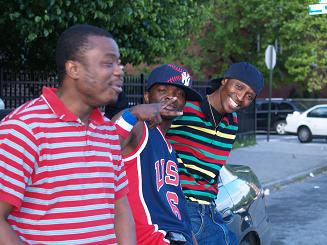WORKING WITH ANIMATION

Ever since I heard Brett Morgen of “Chicago 10” speak about using innovative technologies in storytelling, I’ve been curious how to integrate mixed media in my work. Liberia??? Check! is the first project where I’m working with animation and I’m learning a lot in the process.
I decided after not being able to pull enough young Liberians in Park Hill together for a mock debate about the elections, that I would set up my piece as sort of a “delegates” meeting where representatives from places like Colombia, Palestine, Jamaica and finally, Liberia, are given the opportunity to share their thoughts on the election. My good friend, Sol Guy, whose own work I really respect agreed to do the voice over for “MC Unite” who is presiding over the meeting. It was fun to work on this with Sol because he also shot a segment in Liberia so we talked about how interesting it is that Liberia is so fascinated with the U.S. (A short plug – he traveled with the artist, MIA, to check out the work of youth advocate, Kimmie Weeks, for his new MTV Canada 4Real.com – check it out to learn more about Liberia.) When MC Unite calls up PJ – our Liberian delegate – we segue into a video shown to the delegates which gives context to U.S.-Liberian relations and then on to the footage I have of him in Park Hill.
Lovisa Inserra is my new animator and she is fantastic! We decided to first develop the storyboards for the piece that she will then animate once we get feedback from the Open Call community. Pulling the stills she created into my sequence, I came to realize that when you decide to work in animation, you essentially become a sound designer. The background noises of the courtroom, the VO, the music, the clanking of the gavel, all help to enhance the credibility of the scene. So, I had to add about 6 audio channels to get it going.
The other interesting thing about working in animation -and probably in fiction in general which I don’t get a lot of exposure to – is the ability to “set up” scenes in order to relay information critical to your story. After going through my interviews and footage with PJ, I realized that in order to best contextualize the relationship between Liberia and the U.S. (in a few seconds!), that I will need him to read from a script. I’ll cover this with archival images from the slave trade from the WGBH Sandbox and my own broll of contemporary life in Monrovia, but because I didn’t think of this prior to shooting, I will definitely need to make another trip out to Staten Island. Not sure yet what I’ll add in place of it for my initial rough cut.
I’ll end this with posting a few more stills from the opening animated scene. I opted to go for a very colorful, youth feel in order to attract a younger audience.





 Posted by Lisa Russell
Posted by Lisa Russell 

